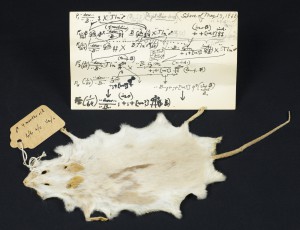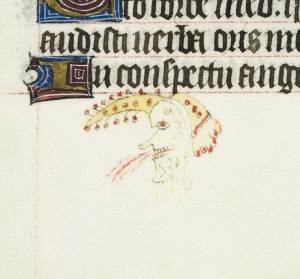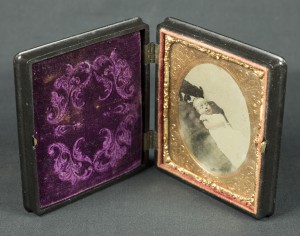To celebrate Halloween, we’ll be counting down thirteen of the weirdest, creepiest, and most unusual items found in the depths of the Lilly Library’s collections. Among the most beautiful and hallowed books treasured by collectors throughout generations, we’ve accumulated some objects that also excite the dark side of our imagination… and what better time to revel in the dark, strange, and fantastic than Halloween? We’ll be posting all thirteen here on our blog, but you can also follow us on Twitter @IULillyLibrary to see more images of these spooky treasures.
Number 7: The Muller Mouse (ca. 1945-1964)

I bet you didn’t know that there’s a mouse in the Lilly Library. While we have never spotted any live rodents (save the flying squirrels that occasional come down the chimney), there is a mouse skin in the Lilly Library’s collections. The mouse resides among the papers of Hermann Joseph Muller (1890-1967) geneticist and Nobel prize laureate. Among numerous other prestigious appointments, Muller was a Research Professor in the Indiana University Department of Zoology from 1945 until his retirement in 1964. A year after his arrival at IU, Muller received the Nobel Prize for his discovery that genetic mutations can be induced by x-rays. He received many more awards and tributes over the years, including the Bossom Award, the Kimber Genetics Award, and several honorary doctorates. In his work in genetics, Muller worked with innumerable mice and fruit flies; we don’t know why this particular mouse was so special that his skin was preserved. It was kept with Muller’s papers and the material from his desk along with a genetic pedigree (seen in photo).
Number 6: Momento Mori (late 15th century)

The extensive collection of medieval and Renaissance manuscripts at the Lilly Library are usually described as “beautiful,” “breathtaking,” and “inspiring”–seldom as “spooky.” However, some medieval texts contain images called “Momento Mori,” a Latin phrase meaning, “Remember you will die.” These are reminders that all beauty and all things are transient and earthly life and material objects are, in the end, mere vanity. This skull wearing a belled hat (the symbol of the fool) and spitting blood is found in Ricketts 130, a late 15th-century French Book of Hours. It is not part of the intentional design but rather a doodle added by an owner or reader.
Number 5: Postmortem Photograph (19th century)

Postmortem photography is the practice of taking pictures of the recently deceased. While this may seem horrendously morbid today, in the 19th century, the practice helped families to remember the beloved dead and move forward in the grieving process. It was an especially common practice for infants who died in the home; these photos would be the only image and record for a family to remember a departed child. Infant mortality was high, but families still wanted to remember those who were with them even for only a short time. The photo here comes from the papers of the Woodward family of Buena Vista, Monroe County, Indiana.Stay tuned the next installment of Spooky Treasures on October 27 and be sure to follow us on Twitter @IULillyLibrary to see more images of these spooktacular items.
Rebecca Baumann
Education and Outreach Librarian / She-Who-Lurks-in-the-Stacks